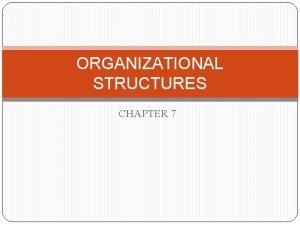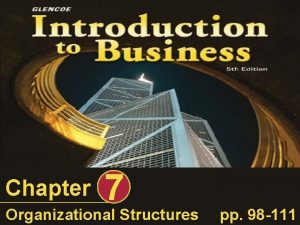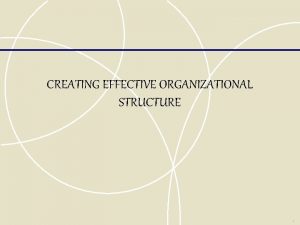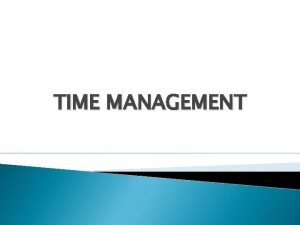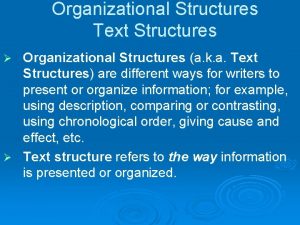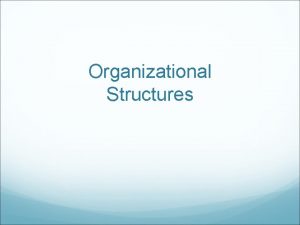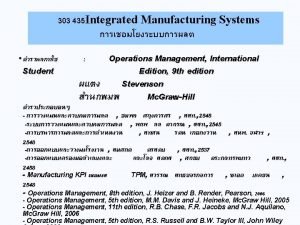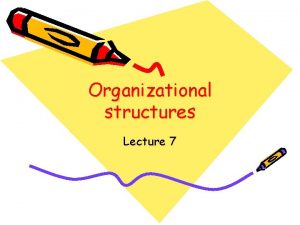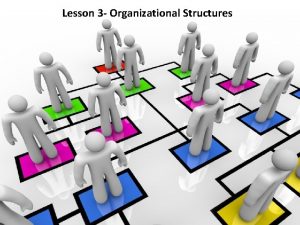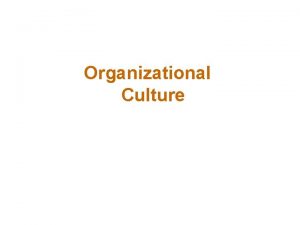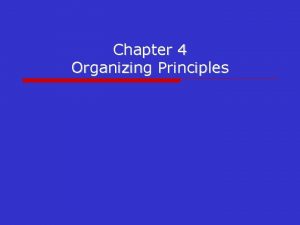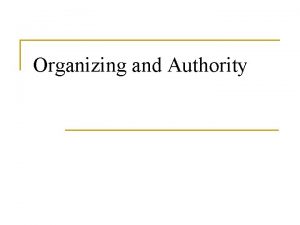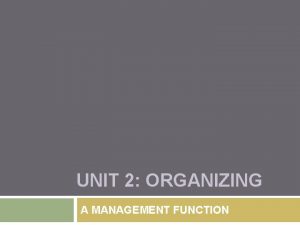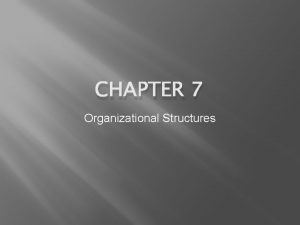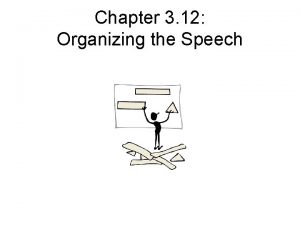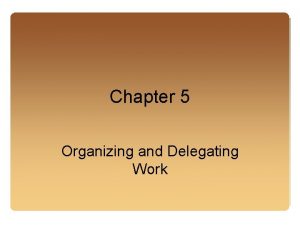ORGANIZATIONAL STRUCTURES CHAPTER 7 ORGANIZING FOR MANAGEMENT As























- Slides: 23

ORGANIZATIONAL STRUCTURES CHAPTER 7

ORGANIZING FOR MANAGEMENT As a successful business owner, you’ll want to accomplish your goals. Your business needs some form of organization that identifies who is responsible for which tasks.

MANAGERIAL STRUCTURES Any business that employs more than 1 person needs a management plan = divides a company into different departments run by different managers direct workers, coordinate activities, solve problems that might occur Companies use an organizational chart = shows how the business is structured and who is in charge of whom CEO VP VP Mgr.

MANAGERIAL STRUCTURES (cont. ) One way to organize management = line authority managers at the top of the line are in charge of those beneath them centralized organization = puts authority in 1 place, with top management decentralized organization = gives authority to a number of different managers to run their own departments used if you like to run all aspects of your company but it is too much for one person

Centralized

Decentralize d Lattice Organizational Structure

2 TYPES OF STRUCTURE FORMAL Usually departmentalized = divides responsibility among specific units, or departments Departments can be organized by what they do, what they make, or by region Depending on size of business, may need managers throughout INFORMAL Usually smaller businesses If business doesn’t need (for instance) a big marketing or distribution network, it doesn’t need a lot of managers Employees can be more flexible and share the duties

3 LEVELS OF MANAGEMENT Top-level Managers Responsible for setting goals and planning for the future Have titles like president, vice president, and chief executive officer (CEO) Usually consists of a small group of people, or even 1 person Middle Managers • Carry out the decisions of top management • Include plant managers, regional managers, and department heads • Responsible for planning and controlling an operation Operational Managers Responsible for the daily operations of the business Supervisors, office managers, and crew leaders are types of operational managers Duties include overseeing workers and meeting deadlines

MANAGERIAL FUNCTIONS A good manager carries out the 4 different functions of business: planning and staffing, organizing, leading, and controlling. Some decisions are routine – others are risky. Sometimes long-term goals have to be changed because of short-term problems.

Planning and Staffing Management must answer the following questions: What must be done? Who will do it? How will the work be grouped? Who supervises whom? Who makes decisions about the work to be done? These questions are applied answered with the management team Good planning requires setting realistic goals When businesses contemplate expanding they must consider things like – is there a big enough market? What kind of technology should be used? How long will it take to produce the new products? Long-range planning involves top-level management deciding how the company should perform

Organizing To organize a business plan you need to assign managers different tasks and coordinate their activities each manager needs to organize his or her department and know what they other managers are doing they also need to know how much money they have in the budget to carry out their tasks finally, managers need to determine who makes decisions and who answers to whom

Leading The primary objective of a good manager is to help each person in the company work to his or her potential Good management requires good leadership Characteristics of a good leader: create a vision of the company to inspire their employees set standards, such as deadlines and sales quotas communicate to provide guidance and resolve conflicts offer training encourage employees

Controlling Responsibilities of a good controller: Keeping the company on track and making sure all goals are met keep track of the budget keep track of the schedule keep track of the quality of the product monitor employees and review their performance find out what went wrong and fix it if things don’t go according to plan

MANAGEMENT FUNCTIONS Managers carry out 4 different functions: PLANNING ORGANIZING CONTROLLING LEADING

IS BEING A MANAGER FOR YOU? Most managers begin their career as a company employee and are promoted after they have gained experience and have shown certain qualities: ability to perform varied activities ability to work under pressure effective communication interpersonal skills ability to gather and use information

If You Were Offered a Job with Management Responsibilities, Would You Take It? Advantages earn more money more respect prestige more influence on how company is run more authority in planning, organizing, directing, controlling, and evaluating company resources varied duties greater control over how their time is spent Disadvantages Get the blame when things go wrong Targets for criticism Mistakes can be more costly because their decisions affect many workers Get a lot of pressure to do things right the first time Strain on relationships – employees often act differently in front of their managers

Leadership Chapter 8 Fundamentals of Business

What’s the Difference? • Management: A job • Managing projects, people, and situations in a company • Leadership: A skill • Providing direction and vision for a company

Leadership Qualities • Motivation • Having initiative – desire to take action and get things done • Having a goal and inspiring others with it • Motivating others to get things done • Confidence • Know what you are doing • Plan to reach your goal • Be decisive • Learn from your mistakes

Leadership Qualities • Communication • Human Relations – ability to communicate with others • Be a good listener • Integrity • Having principles such as honesty, loyalty, and fairness • Set a good example

Leadership Styles • Autocratic Leadership • • “Self-ruling” Run everything yourself and answer to no one Fear and intimidation Democratic Leadership • • Managers and employees work together to make decisions New ideas are encouraged

Leadership Styles • Free-Rein Leadership “Hands-Off” approach Set goals and leave employees alone to get the job done Delegation: giving employees the power to run things and make decisions • • Self-Managed Teams Work groups that supervise themselves • • Team leaders rather than managers

Do all countries look at management the same? You will be creating a flyer to display management in different cultures 1. Look up their management/leadership styles 2. Address the following information: 1. Negotiation 2. Bargaining 3. Expressions of uncertainty, satisfaction, refusal, etc 4. Non-verbal communication 5. Do’s and Don’ts
 Lattice organizational structure
Lattice organizational structure Chapter 7 organizational structures
Chapter 7 organizational structures Analogous structures
Analogous structures Organization structure in school
Organization structure in school Influences of organizational structures on projects
Influences of organizational structures on projects Organizational design traditional structures
Organizational design traditional structures Time management is the process of organizing and planning
Time management is the process of organizing and planning Time management is the process of organizing and planning
Time management is the process of organizing and planning Ob model
Ob model Organizational change and stress management
Organizational change and stress management Chapter 2 worksheet organizing and administering
Chapter 2 worksheet organizing and administering Chapter 17 organizing life's diversity answer key
Chapter 17 organizing life's diversity answer key Kontinuitetshantering i praktiken
Kontinuitetshantering i praktiken Typiska novell drag
Typiska novell drag Nationell inriktning för artificiell intelligens
Nationell inriktning för artificiell intelligens Returpilarna
Returpilarna Varför kallas perioden 1918-1939 för mellankrigstiden?
Varför kallas perioden 1918-1939 för mellankrigstiden? En lathund för arbete med kontinuitetshantering
En lathund för arbete med kontinuitetshantering Underlag för särskild löneskatt på pensionskostnader
Underlag för särskild löneskatt på pensionskostnader Personlig tidbok fylla i
Personlig tidbok fylla i Anatomi organ reproduksi
Anatomi organ reproduksi Vad är densitet
Vad är densitet Datorkunskap för nybörjare
Datorkunskap för nybörjare Stig kerman
Stig kerman
